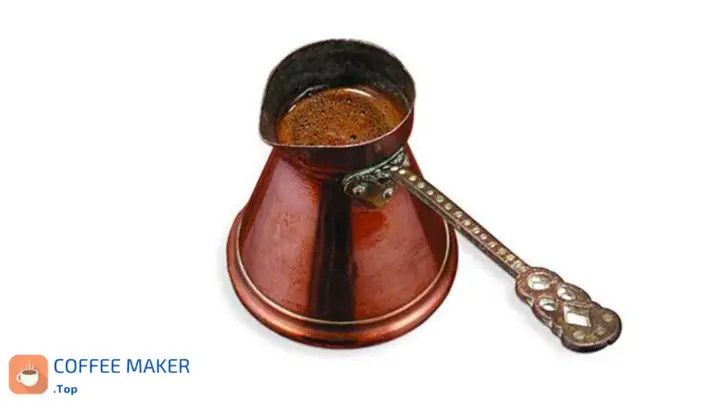Turkish coffee is a beverage steeped in history and tradition. It is known for being a coffee that does not need a coffee maker to prepare it (a kind of long-handled pot is used, which I will tell you about later), and it is drunk unfiltered, i.e. it contains grounds at the bottom of the cup.
Its preparation requires a special technique and offers a unique experience for coffee lovers. In this article, I will show you the 5 essential steps to prepare Turkish coffee and enjoy its aromatic and distinctive taste.
How to prepare Turkish coffee?
Ingredients and tools
| Time | 15 minutes |
| Ingredients | 15 ml of very finely ground Arabica coffee 50 ml of filtered water per cup of coffee Sugar to taste |
| Tools | Cezve Small cups without handles |
The preparation of Turkish coffee is considered a true art, as it involves following specific steps and using the right tools:
- This delicious drink requires a coffee pot called a Cezve, a small pot with a long handle designed especially for this procedure.
- Turkish coffee is characterised by using very fine ground Arabica coffee beans, which are not filtered during the process. To achieve the correct fineness, I advise you to use a hand grinder and take the time to obtain a uniform grind, similar to a soft powder.
- I recommend using filtered water for the best results during the preparation process.

Turkish coffee is characterised by its unique way of preparation. Here are the 5 basic steps to make Turkish coffee:
- Place the Cezve or Turkish coffee pot on the fire with water and wait for it to boil (50 ml per cup).
- Remove the Cezve from the heat when the water reaches boiling point, and add one tablespoon of coffee (15 ml) for each cup you will brew.
- If foam forms with the first boil of the coffee, quickly remove it and pour it into the cups using a small spoon (this step is optional).
- Return the Cezve to the heat and reduce the temperature to the minimum. When the coffee returns to a boil, pour it into the cups, filling them halfway and pouring it over the foam if you have any.
- Continue boiling the remaining coffee in the Cezve for approximately 15 seconds more. Then add a teaspoon of cold water to settle the grounds at the bottom and pour the coffee back into the cups.
Once brewed, it is important to let the drink steep so that the coffee sediment settles to the bottom of the cup. After this last step, add sugar to taste and enjoy this delicious infusion prepared with the Cezve coffee maker.
Turkish coffee curiosities
Turkish coffee is a fascinating drink with several curiosities worth knowing. Originating in the Ottoman Empire in the 16th century, the Ottomans adopted coffee from the Arabs and made it an essential part of their culture. Since then, Turkish coffee has been appreciated and enjoyed for generations.
Preparing and consuming Turkish coffee is more than just a simple act; it is an important social ritual in Turkish culture. Inviting family, friends or neighbours to share a cup of Turkish coffee is a common way of connecting and strengthening bonds.
One of the distinctive characteristics of Turkish coffee is its strength. Due to the fine grinding and concentration of the coffee, a cup of Turkish coffee has an intense flavour and a unique sensation on the palate.
To enhance the Turkish coffee experience, it is commonly served with Turkish sweets such as lokum or baklava. These sweets contrast the strong taste of the coffee and provide a delicious balance. The combination of flavours and textures creates a complete and satisfying sensory experience.
So, the next time you enjoy a cup of Turkish coffee, remember its rich history, the social value it represents, its distinctive strength and the harmony found when combined with traditional Turkish sweets.
Turkish coffee is more than a beverage; it is a cultural treasure that captivates Turks and coffee lovers worldwide.
How to serve Turkish coffee?
To enjoy your Turkish coffee to the fullest, knowing how to serve it properly is important. Here are some tips to help you have a pleasant and authentic experience:
- Turkish coffee is served in special cups called “fincan“. These cups are small and decorative, usually made of porcelain with an elegant design. Their size allows the intensity and aromas of Turkish coffee to be enjoyed in a concentrated form.
- A special tray is usually decorated with Turkish motifs when presenting Turkish coffee. The coffee cups are arranged on this tray, and a sugar container is often included for those who wish to sweeten their coffee.
- Before pouring the coffee, it is important to shake the cup gently. This allows the coffee grounds at the bottom to settle and ensure that the drink remains clear and free of grounds while it is enjoyed.
- A distinctive aspect of Turkish coffee is that it is not stirred after being served. The coffee grounds remain at the bottom of the cup and do not mix with the drink. When drinking it, it is essential to keep this in mind to avoid consuming the grounds.
- To complement the Turkish coffee experience, it is often served with a glass of cold water. The water is a refresher to cleanse the palate before and after drinking the coffee, allowing you to appreciate this drink’s unique flavours and aromas fully.
